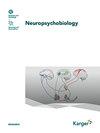Mobile Data Collection of Cognitive-Behavioral Tasks in Substance Use Disorders: Where Are We Now?
IF 3.1
4区 心理学
Q3 NEUROSCIENCES
引用次数: 7
Abstract
Introduction: Over the last decades, our understanding of the cognitive, motivational, and neural processes involved in addictive behavior has increased enormously. A plethora of laboratory-based and cross-sectional studies has linked cognitive-behavioral measures to between-subject differences in drinking behavior. However, such laboratory-based studies inevitably suffer from small sample sizes and the inability to link temporal fluctuations in task measures to fluctuations in real-life substance use. To overcome these problems, several existing behavioral tasks have been transferred to smartphones to allow studying cognition in the field. Method: In this narrative review, we first summarize studies that used existing behavioral tasks in the laboratory and self-reports of substance use with ecological momentary assessment (EMA) in the field. Next, we review studies on psychometric properties of smartphone-based behavioral tasks. Finally, we review studies that used both smartphone-based tasks and self-reports with EMA in the field. Results: Overall, studies were scarce and heterogenous both in tasks and in study outcomes. Nevertheless, existing findings are promising and point toward several methodological recommendations: concerning psychometrics, studies show that – although more systematic studies are necessary – task validity and reliability can be improved, for example, by analyzing several measurement sessions at once rather than analyzing sessions separately. Studies that use tasks in the field, moreover, show that power can be improved by choosing sampling schemes that combine time-based with event-based sampling, rather than relying on time-based sampling alone. Increasing sampling frequency can further increase power. However, as this also increases the burden to participants, more research is necessary to determine the ideal sampling frequency for each task. Conclusion: Although more research is necessary to systematically study both the psychometrics of smartphone-based tasks and the frequency at which task measures fluctuate, existing studies are promising and reveal important methodological recommendations useful for researchers interested in implementing behavioral tasks in EMA studies.物质使用障碍中认知行为任务的移动数据收集:我们现在在哪里?
引言:在过去的几十年里,我们对成瘾行为中涉及的认知、动机和神经过程的理解大大增加。大量基于实验室和横断面的研究将认知行为测量与受试者之间饮酒行为的差异联系起来。然而,这种基于实验室的研究不可避免地存在样本量小的问题,并且无法将任务测量的时间波动与现实生活中物质使用的波动联系起来。为了克服这些问题,一些现有的行为任务已经转移到智能手机上,以便在该领域研究认知。方法:在这篇叙述性综述中,我们首先总结了在实验室中使用现有行为任务的研究,以及在该领域中使用生态瞬时评估(EMA)的物质使用自我报告。接下来,我们回顾了基于智能手机的行为任务的心理测量特性研究。最后,我们回顾了在该领域使用基于智能手机的任务和EMA自我报告的研究。结果:总体而言,研究在任务和研究结果方面都是稀缺和异质的。然而,现有的研究结果是有希望的,并指向了几个方法论建议:关于心理测量学,研究表明,尽管需要更系统的研究,但任务的有效性和可靠性可以提高,例如,通过同时分析几个测量环节,而不是单独分析环节。此外,使用该领域任务的研究表明,可以通过选择将基于时间的采样与基于事件的采样相结合的采样方案来提高功率,而不是仅依赖于基于时间的抽样。增加采样频率可以进一步增加功率。然而,由于这也增加了参与者的负担,因此需要进行更多的研究来确定每项任务的理想采样频率。结论:尽管有必要进行更多的研究来系统地研究基于智能手机的任务的心理测量和任务测量波动的频率,但现有的研究是有希望的,并揭示了重要的方法建议,这些建议对在EMA研究中实施行为任务的研究人员有用。
本文章由计算机程序翻译,如有差异,请以英文原文为准。
求助全文
约1分钟内获得全文
求助全文
来源期刊

Neuropsychobiology
医学-精神病学
CiteScore
7.20
自引率
0.00%
发文量
26
审稿时长
6 months
期刊介绍:
The biological approach to mental disorders continues to yield innovative findings of clinical importance, particularly if methodologies are combined. This journal collects high quality empirical studies from various experimental and clinical approaches in the fields of Biological Psychiatry, Biological Psychology and Neuropsychology. It features original, clinical and basic research in the fields of neurophysiology and functional imaging, neuropharmacology and neurochemistry, neuroendocrinology and neuroimmunology, genetics and their relationships with normal psychology and psychopathology. In addition, the reader will find studies on animal models of mental disorders and therapeutic interventions, and pharmacoelectroencephalographic studies. Regular reviews report new methodologic approaches, and selected case reports provide hints for future research. ''Neuropsychobiology'' is a complete record of strategies and methodologies employed to study the biological basis of mental functions including their interactions with psychological and social factors.
 求助内容:
求助内容: 应助结果提醒方式:
应助结果提醒方式:


